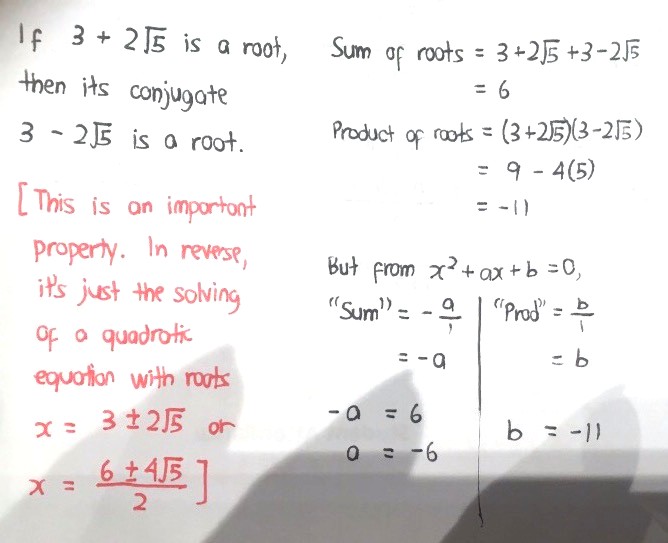Eric Nicholas K's answer to AX's Secondary 4 A Maths Singapore question.
done
{{ upvoteCount }} Upvotes
clear
{{ downvoteCount * -1 }} Downvotes
Here
Date Posted:
4 years ago
So does the trick only applies to those quadratic equations which its roots cannot be expressed as a fraction and can only be solved using quadratic formula?
If the equation has fractional roots, such as 0.5x2 + 0.25x - 1 = 0, we can multiply both sides of the equation by the “LCM” of the denominator, which in this case is 4, to give
2x2 + x - 4 = 0,
with integer roots. As long as the coefficients and the constant term are all rational numbers, the trick always applies.
2x2 + x - 4 = 0,
with integer roots. As long as the coefficients and the constant term are all rational numbers, the trick always applies.
The thing is, in the quadratic formula, the formula contains plus minus the square root of the discriminant. Sometimes the square root can be simplified into an easy number (but if that is the case, you would have done cross factorisation already).
The trick always applies in any case actually, but more so if the root contains a square root.
Actually for the case where it can be simplified, say x2 - 4x + 3 = 0, you will get x = 1 or 3. With the formula it appears to be 4 +- sqrt 4, whole thing divided by 2. It’s just harder to see in this case because the square root immediately simplifies. When the square root is more evident (as is the case in the question), then the rule becomes more obvious.
The trick always applies in any case actually, but more so if the root contains a square root.
Actually for the case where it can be simplified, say x2 - 4x + 3 = 0, you will get x = 1 or 3. With the formula it appears to be 4 +- sqrt 4, whole thing divided by 2. It’s just harder to see in this case because the square root immediately simplifies. When the square root is more evident (as is the case in the question), then the rule becomes more obvious.
Thank you, I learnt a new thing today.
Another way to do this question :
We rewrite the expression to fit (-b ± √(b² - 4ac))/2a
Since know coefficient of x² (as seen in the question) is 1, the a here = 1
3 + 2√5
= (6 + 4√5)/2
= (6 + √(5 x 4²))/(2(1))
= (-(-6) + √80)/(2(1))
Comparing coefficients with x² + ax + b = 0,
integer a = -6
Discriminant = 80.
Since integer a = -6 and coefficient of x² in the question is 1,
(-6)² - 4(1)(integer b)= 80
4 x integer b = -44
Integer b = - 11
We rewrite the expression to fit (-b ± √(b² - 4ac))/2a
Since know coefficient of x² (as seen in the question) is 1, the a here = 1
3 + 2√5
= (6 + 4√5)/2
= (6 + √(5 x 4²))/(2(1))
= (-(-6) + √80)/(2(1))
Comparing coefficients with x² + ax + b = 0,
integer a = -6
Discriminant = 80.
Since integer a = -6 and coefficient of x² in the question is 1,
(-6)² - 4(1)(integer b)= 80
4 x integer b = -44
Integer b = - 11



